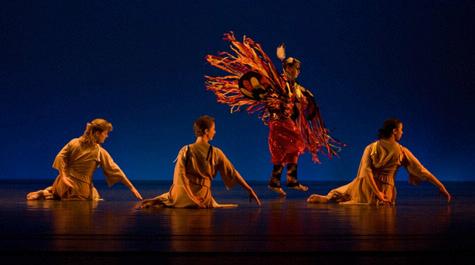DANCEVENT: 'A full spectrum of possibility'
On her research leave, William and Mary modern dance professor Denise Damon Wade found herself not in Europe or a library, but on the pink-tinted gravel and unique curves of "The Mother Road"-Route 66. She and her husband traveled the part of the road that stretched from St. Louis to Albuquerque, N.M. They encountered horses, old farm land and new roads that had been paved over the old route. More importantly, however, Wade found the inspiration she had been looking for all along.
The result? A 20-minute modern ballet piece featuring the music of Virgil Thomson's "Filling Station." Inspired by the music that had been passed to her by William and Mary Music Director Gary Green, Wade was able to build a story of truckers, bootleggers, State Troopers and Okies centered around a small filling station in 1930s Oklahoma.
Her piece is one of many featured in the College of William and Mary Dance Program's DANCEVENT. Wade, along with dance professors Joan Gavaler and Leah Glenn not only developed and choreographed the pieces in the program, but also perform in them alongside members of Orchesis and guest performers.
Galaver alone has four pieces in the concert: "Symbol," "Rapid Eye Movement," "String of Pearls," and "Fiddle Dances," each of which pose different, sometimes challenging, opportunities to express her stories and messages. The spirit of collaboration is seen in each dance. "Symbol" features music by Maria Figueroa of the Taino people and Larry Tait of the Nisga'a people, with help from props created by visual artist and professor, Elizabeth Mead. Figueroa and Tait bring both music and pieces of their culture to their performances, including a four-foot-long mask from the Raven Dance of Tait's tribe.
"What I did was create a piece that, in a more abstract process, speaks to the idea of something being created, pulled apart and reformed," Galaver said. Though she chooses to ground the piece in Native American culture, she explained, "[It's] a broad story-a shared story-that is something many people can relate to. If you've been adopted, you're trying to reconstruct who you are, or if you've lived through a natural disasters and have been pulled apart from others."
DANCEVENT also marks her first time collaborating with students in last spring's physical theater class in "Rapid Eye Movement." Both the physical theater class and the piece use elements of theater and improvisation. Developed with the students, the piece asks the question, "What happens when the Dream is separated from the Dreamer?"
Though much of the collaboration in DANCEVENT is with professors and performers outside of the dance department, Wade's "He Loves Me, He Loves Me Not," features a performance by both Wade and Glenn. "We had an incredible amount of fun," Glenn said. "It's a great milestone for us."
Glenn has two pieces she developed in the program: "Transcending Rhythms," a testimony to the endurance of Africa and Native American cultures and "Limon Etude," a reconstruction of Jose Limon's work. The list of collaborators for "Transcending Rhythms" speaks to her desire to celebrate both the beauty and pride expressed in the dance forms and music of these cultures. African percussionist, Orimolade Ogunjimi and Youghtanund members Danielle Bradby (Chicahominy), Aaron Winston (Mcherrin), Pernel Richardson (Haliwa-Saponi) and Thomas Tupponce Jr. (Upper Mattaponi).
"When you're collaborating with live musicians and you have all these other pieces and supportive elements to incorporate, it just makes for chaos," said Glenn with a faint smile. "My dancers have just embraced everything thrown at them and have worked so hard, and it really shows."
Also difficult was working with dancers on recreating the Limon style of dance, which Glenn describes as being "very lyrical, with falls, extensions and recoveries." The reconstruction of Limon's work focuses on three of his pieces: "Psalm," "Dances for Isadora," and "A Choreographic Offering," in what Glenn hopes it will give the public access to incredible historical dance works.
All three professors bring complementary notions of heritage and pride to their pieces, though Wade claims it was done unintentionally.
"We are all on our own journeys," she said. "A choreographer, for me, since I can only speak for myself, is like a writer-a writer writes what he knows, and a choreographer does the same. You write about what you've experienced or what you're learning or what you're interested in. You're always looking for things that are meaningful to you to choreograph about."
Though their pieces always, at their heart, feature a meaning or an idea, Galaver is quick to protest the idea that modern dance is inaccessible to the general public.
"Modern dance isn't all seriousness and deep meaning that you must decipher or you are not very intelligent-rather, modern dance is a full spectrum of possibility from comedic to dramatic to abstract and beautiful and that you don't need a special training to enjoy a concert," she said. "We would hope that people would take a chance and if they've not come to see dance lately or at all in their life, that they would just come and check it out."
The concert of faculty research runs between Oct. 30 and Nov. 1 and begins at 8 p.m. on each night in Phi Beta Kappa Memorial Hall.
A video commercial was created for the event and can be viewed on YouTube at: http://www.youtube.com/watch?v=nFdQWjwNMVA.
















